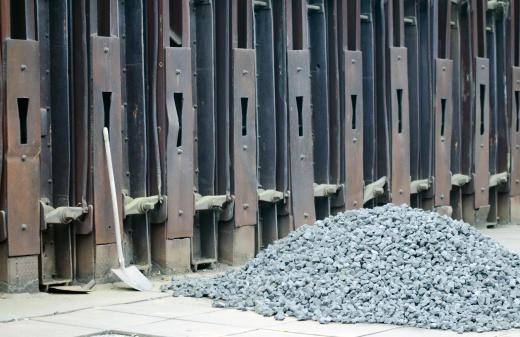Steel has been an important part of construction since the 1800s, because of its versatility as a building material. Its popularity is largely due to its strength and ease of manufacturing. The raw materials for steel vary because different steels can be made to suit their end uses, including softer steel for machining to very hard steel for security devices or safes. All steel products are valued for their strength, durability and ease of recycling when no longer needed.
The key ingredient for steel is iron that is found in the ground as oxide, a chemical mixture of iron and oxygen mixed with rock. Oxidized iron is common in steel products as they age, because the same molecule is known as rust, which occurs when the iron and oxygen re-combine over time. A high-temperature vessel called a blast furnace is used to prepare the pure metal from the raw ore. Before iron can be placed in the furnace, it typically goes through several processing steps to remove waste rock and concentrate the iron percentage in the ore.

In a blast furnace, the iron ore and other raw materials for steel are added and heated to very high temperatures. When the mixture is molten, oxygen is injected using a hollow pipe called a lance, which causes the mixture to become even hotter. At the very high temperatures, oxygen is separated from the iron oxide, resulting in pure metal. Impurities called slag rise to the top of the furnace and are removed, resulting in a molten mixture of iron and other additives.

There are hundreds of different steel compositions or alloys, but there are a few common raw materials for steel. Carbon is a key ingredient in all steel, but is present at low concentrations. The oxygen in ore reacts with the carbon added to the furnace, removing it from the iron oxide molecule. A pure form of carbon called coke is needed in a blast furnace, and it is prepared by heating coal to high temperatures to remove any organic compounds.

Iron with carbon percentages higher than two percent is referred to as cast iron, which is hard but more brittle. Other raw materials for steel include different metals, silicon and limestone. The limestone, which is calcium carbonate, is called a flux and is added at regular intervals to the furnace to form the slag and remove impurities. Silicon removes oxygen in the furnace and makes the steel more workable, or easier to be bent or machined.

A blast furnace can use some recycled steel, but is typically limited to about 30 percent by weight. Steel is easily recycled, but a different furnace called an electric arc furnace is used for higher percentages of recycled steel. An electric arc furnace uses two electrodes suspended inside the furnace, and a high electric current passes between them, creating high temperatures. The raw materials for steel are already contained in the recycled material, and only small amounts of additives may be needed to create a desired steel composition.
